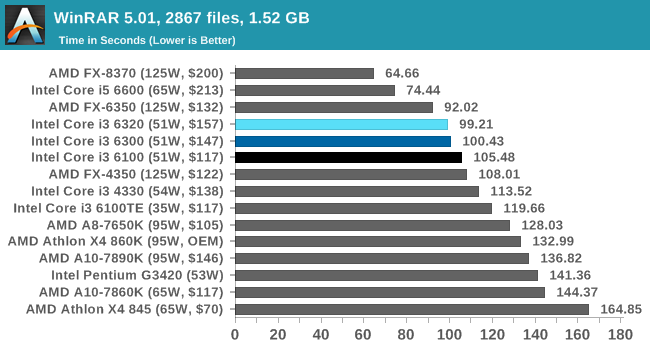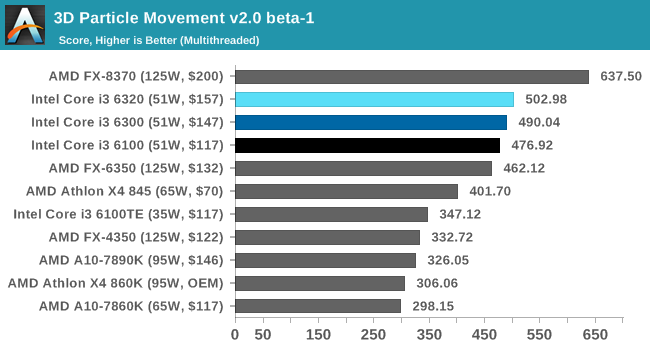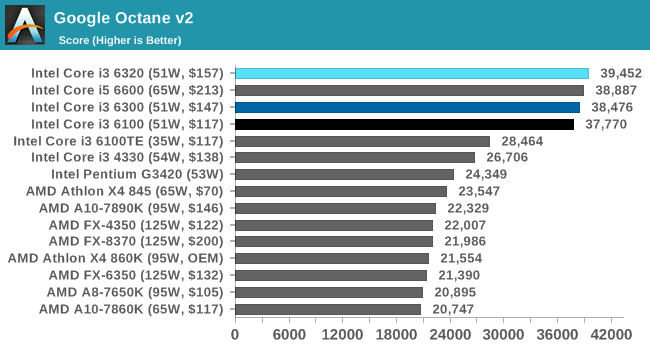The Skylake Core i3 (51W) CPU Review: i3-6320, i3-6300 and i3-6100 Tested
by Ian Cutress on August 8, 2016 9:00 AM ESTReal World Performance
The dynamics of CPU Turbo modes, both Intel and AMD, can cause concern during environments with a variable threaded workload. There is also an added issue of the motherboard remaining consistent, depending on how the motherboard manufacturer wants to add in their own boosting technologies over the ones that Intel would prefer they used. In order to remain consistent, we implement an OS-level unique high performance mode on all the CPUs we test which should override any motherboard manufacturer performance mode.
All of our benchmark results can also be found in our benchmark engine, Bench.
Dolphin Benchmark: link
Many emulators are often bound by single thread CPU performance, and general reports tended to suggest that Haswell provided a significant boost to emulator performance. This benchmark runs a Wii program that raytraces a complex 3D scene inside the Dolphin Wii emulator. Performance on this benchmark is a good proxy of the speed of Dolphin CPU emulation, which is an intensive single core task using most aspects of a CPU. Results are given in minutes, where the Wii itself scores 17.53 minutes.

Skylake saw a good boost with our Dolphin benchmark, and it remains a single-thread driven event. The 100 MHz difference between the i3-6320 and i3-6300 amounts to just over a second difference, but one step back to the i3-6100 is another 42 seconds. This is one of the few instances where the 3 MB of L3 cache on the i3-6100 makes a significant difference. The i5-6600 sits in the middle of our i3 parts due to its lower CPU frequency but higher cache.
WinRAR 5.0.1: link
Our WinRAR test from 2013 is updated to the latest version of WinRAR at the start of 2014. We compress a set of 2867 files across 320 folders totaling 1.52 GB in size – 95% of these files are small typical website files, and the rest (90% of the size) are small 30 second 720p videos.

WinRAR is a variable thread test, so the CPUs with more threads all pull ahead of the i3 parts. Again, we see a crescendo from the i3-6320 to the i3-6300 and the i3-6100, with the i3-6100 being slightly further out due to its reduced L3.
3D Particle Movement v2
The second version of this benchmark is similar to the first, however it has been re-written in VS2012 with one major difference: the code has been written to address the issue of false sharing. If data required by multiple threads, say four, is in the same cache line, the software cannot read the cache line once and split the data to each thread - instead it will read four times in a serial fashion. The new software splits the data to new cache lines so reads can be parallelized and stalls minimized. As v2 is fairly new, we are still gathering data and results are currently limited.

The updated 3DPM benchmark likes good cache management and a high frequency with lots of threads. As from our Carrizo review, the AMD X4 845 does really well here, beating the i3-6100TE which has a much lower frequency. For the i3 parts, we see a regular staircase between the three, outpacing the much older FX-6350.
Web Benchmarks
On the lower end processors, general usability is a big factor of experience, especially as we move into the HTML5 era of web browsing.
Mozilla Kraken

Kraken also enjoys Skylake CPUs, with a preference for high frqeuency parts as well. The regular staircase is in effect between the three, showing how L3 cache makes little difference here.
Google Octane v2

Octane has a similar performance to Kraken, with the Skylake CPUs out in top with the staircase results. The i5-6600 sits in the middle, despite having four physical cores, but restrained to four threads. Because of this and our regular staircase, we can see that the L3 cache plays little role here and the threads are very lightweight. The resources on the FX CPUs unfortunately do not do well here.










94 Comments
View All Comments
DonMiguel85 - Monday, August 8, 2016 - link
I remember in Eurogamer's i3-6100 review, just using 2666 or 3200MHz DDR4 gave a significant performance boost in pretty much all games, especially Ryse whose maximum FPS almost doubled from 59 to over 100FPS. And this was at the stock CPU clockspeed. Minimum frames improved substantially too.wintermute000 - Monday, August 8, 2016 - link
Problem is the price premium for 3200Mhz, you're already halfway to the cost of a dGPU like a GTX950 or R460 that will blow the doors off any iGPUwintermute000 - Monday, August 8, 2016 - link
whoops I guess I was looking at the expensive stuff, realised that not all 3200 is priced that much higherbeginner99 - Tuesday, August 9, 2016 - link
exactly. If you go Skylake, buy 3200 mhz RAM. For 16 GB it's only $20-30 more than 2133 mhz RAM and totally worth it.fanofanand - Monday, August 8, 2016 - link
Fantastic article Ian, you are definitely doing a great job of filling in the "lull" period between major GPU reviews. I have been wanting exactly this review to be done, as I would love to be able to build my kid a cheap computer for school that could do a bit of light gaming. I was really hoping the APUs would give adequate performance, but it looks like I will be waiting for Zen. I really don't want to get a dGPU for his computer and with Intel it doesn't look like there is much of a choice. Zen it is! Please don't disappoint us AMD!BrokenCrayons - Tuesday, August 9, 2016 - link
I'm keenly interested in seeing what Zen brings to the table too. However my next desktop PC upgrade is going to be a GPU of some sort and even that's probably a good 6+ months away if not more. Zen will be another CPU+Mobo+RAM swap and I'm not looking forward to anything of the sort right now...unless Zen can more than double the performance of my 860K, at which point I'll be very interested.Achaios - Monday, August 8, 2016 - link
Bought a brand new laptop today with an Intel Core i5-6200U Skylake onboard (which you have failed to include in your table) clocked at 2.3 GHz which turbos to 2.8 GHz.The thing I wanna say if you try to install Windows 7 on a Skylake machine without making a little in-depth research, you're screwed.
One way to install Windows 7 on Skylake machines is described by the following ASROCK article:
http://www.asrock.com/microsite/win7install/
(Thank you ASROCK).
I am not ashamed to say I spent the better part of day fighting off the dreaded "A required CD/DVD drive device driver is missing" before I had my Windows 7 Pro 64 Bit slipstreamed and updated by ASROCK's app.
Perhaps you should consider adding a couple of words on the subject as there are many ppl who will stay on Windows 7 for several years to come and are not very familiar with the Skylake platform.
DonMiguel85 - Monday, August 8, 2016 - link
Well, of course it's not on the table - that's a mobile chip. Plus unless you have some specific business need to use Windows 7 I don't see why you would go through the hassle of putting it on there. It's an almost 7 year old OS.fanofanand - Tuesday, August 9, 2016 - link
LOL "failed to include" I love it. "I bought it so you should review it, even if it's not even in the same segment as the other products you are reviewing". Classic snowflake narcissism.Meteor2 - Tuesday, August 9, 2016 - link
1. I wish you'd calculated price/performance and power/performance for us, rather than leaving us to guesstimate2. The game benchmarks need 95th (or whatever) percentile frame rates and minimum frame times, as that's where the performance difference between i3 and i5 truly lies.